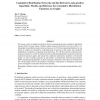Free Online Productivity Tools
i2Speak
i2Symbol
i2OCR
iTex2Img
iWeb2Print
iWeb2Shot
i2Type
iPdf2Split
iPdf2Merge
i2Bopomofo
i2Arabic
i2Style
i2Image
i2PDF
iLatex2Rtf
Sci2ools
JMLR
2011
2011
Cumulative Distribution Networks and the Derivative-sum-product Algorithm: Models and Inference for Cumulative Distribution Func
We present a class of graphical models for directly representing the joint cumulative distribution function (CDF) of many random variables, called cumulative distribution networks (CDNs). Unlike graphs for probability density and mass functions, for CDFs the marginal probabilities for any subset of variables are obtained by computing limits of functions in the model, and conditional probabilities correspond to computing mixed derivatives. We will show that the conditional independence properties in a CDN are distinct from the conditional independence properties of directed, undirected and factor graphs, but include the conditional independence properties of bi-directed graphs. In order to perform inference in such models, we describe the ‘derivative-sum-product’ (DSP) message-passing algorithm in which messages correspond to derivatives of the joint CDF. We will then apply CDNs to the problem of learning to rank players in multiplayer team-based games and suggest several future di...
Conditional Independence Properties | Cumulative Distribution | JMLR 2011 | Joint Cumulative Distribution |
Related Content
| Added | 14 May 2011 |
| Updated | 14 May 2011 |
| Type | Journal |
| Year | 2011 |
| Where | JMLR |
| Authors | Jim C. Huang, Brendan J. Frey |
Comments (0)

